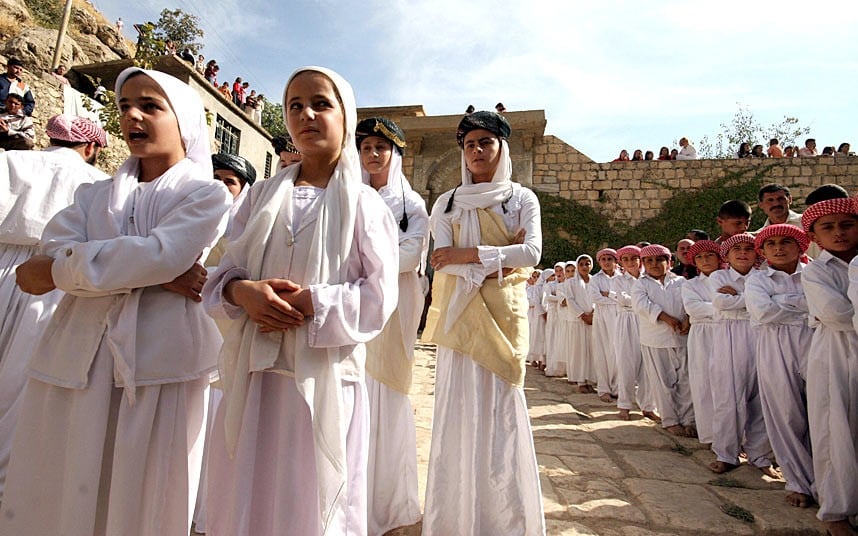News
30 июня 2014 года
Who are the Iraqi Yazidis?

Picture Galleries
Long misunderstood by the outside world as "Devil-worshippers", the Yazidis face a possible genocide at the hands of advancing Islamic State fighters. Here, we take a look at Agence France Presse photographer Safin Hamed's photographic essay on one of Yazidi communites of northern Iraq in 2006 as they prepared for their congregation ritual. Words by Justin Huggler.
Girls and boys from a Yazidi religious school sing hymns and prayers in front of the Yazidis' holiest temple in Lalesh, situated in a valley near Dahuk, 267 miles (430 kms) northwest of the Iraqi capital Baghdad in October 2006.
One of the most persecuted minorities in the Middle East, the Yazidis in fact find even the mention of the word "Satan" profoundly offensive, and have kept their ancient religion alive despite centuries of oppression.
The Yazidis mark themselves out as different. They never wear the colour blue. They are not allowed to eat lettuce.
For ordinary Iraqis, they are bogeymen to frighten children with. But for religious extremists through the centuries, they have been Devil-worshippers to be slaughtered.
The misidentification came about because the Yazidis worship a fallen angel, the Malek Tawwus, or Peacock Angel. But, unlike Lucifer, the Yazidis' fallen angel was forgiven by God and restored to heaven.
Their religion is not just an offshoot of Christianity or Islam. They do not believe in heaven or hell, but in reincarnation, which they describe as the soul "changing its clothes".
Here, Iraqi Yazidi women perform a religious ritual by scrapping shavings off a sacred log to help their children sleep well at night.
They have kept their religion alive through the Talkers, men who are taught the entire text of their missing holy book - believed to have been stolen by the British in colonial times - by memory as children, and who in turn pass it on to their own sons.
An Iraqi Yazidi Sheikh gives his blessing to a woman at the Lalish temple.
The Yazidis once lived in a wide area, across Iraq, Syria, Turkey, Georgia and Armenia.
A Yazidi embraces a pillar as he makes a wish at the Lalish temple.
Most have fled to Australia, Canada and Germany, but, against all the odds, Iraq is the one place in the Middle East where a sizeable community remains, albeit now under threat of genocide by the Islamic State.
Iraqi Yazidis kiss the ground as they arrive at the Lalish temple.
In Turkey, they faced double discrimination as both non-Muslims and Kurds, and were forced to carry identity cards that listed their religion as "XXX". In Georgia and Armenia, they fell foul of nationalist movements after the fall of the Soviets.
A ritual wall kiss at the Lalish temple.
The Yazidis speak Kurdish – they claim theirs is the ancient Kurdish religion – but they have a troubled history with their Kurdish neighbours too.
Men sweep the courtyard around the temple.
Their traditions make them highly visible as a separate community. The Yazidis do not practise arranged marriage, like other communities in the region. They have a formal system of elopement, where a man must "kidnap" his bride. If the woman is willing, the parents have to accept the match.
Women stand at the entrance of Lalish temple.
There are darker sides to the Yazidis. They have a tradition of killing any of their members who leave the religion, and 2007 it was reported that Du'a Khalil Aswad, a Yazidi woman, was stoned to death for converting to Islam and marrying a Muslim man.
Yazidis gather outside sacred tunnels under the Lalish temple.
The Yazidis say they have survived 72 genocides. Now there are fears the last community of them in the Middle East is facing another.
Yazidis are seen inside sacred tunnels under the Lalish temple.
Source: The Telegraph

